|
Advertisement / Annons: |
My travels in Sweden:
|
Contents:
|
|
You can use the maps from Stockholmskällan. It has the function that you can compare maps from different years. It's only one map that cover the areas outside Stockholm City, the map from 1934. |
|
Earlier we have walked along Northern Hammarby Lake, today we took the bicycles to investigate the Southern Hammarby Lake. Hammarby Lake is not a lake today, about 1930 they open it up to the Baltics Sea and with a lock to the lake Mälaren. During this they lowered the water level of the lake by 5 meters. I have added links with deeper information, most of them are Wikipedia links. I have chosen the Swedish link, but in some cases you can shift to English. If there is no English version you can use Google translator or similar service. There are more information in the Swedish language. Harbors along Southern Hammarby Lake:Map over our walk:Walk along Southern part of Hammarby Lake, it's about a 4.5 km long walk. Skanskvarn:
Already when we are closing in to Skanskvarn we see something that have changed, there is a big tower in front of us. On the Southern side of Hammarby lake is Hammarby Sea Town, very intensive of building projects the last 20 years and even today. 
In the 1940s my parents didn't live far from this mill, they visit it often for a cup of coffee. More to read about Skanskvarn at Wikipedia:
Årstaviken:
We walked down the hill on the Western side of Skanskvarn and got more news, they are building a working tunnel for the new blue line subway. That's the subway line we use. 
The entrance to the working tunnel. 
Here we are in level with the water. A marine shop has it store here and it has been at this place as long I can remember. 
Out on the boat dock we can see Årsta train bridge in background. This is Årstaviken. Sundby Gård:
In the other direction we have a complex of different bridges, these two are road bridges with the last having subway rails at the edge. The house we see is the Sundby Gård (Yard). More to read about Sundby Gård at Wikipedia:

The rusty iron port we see in front of us belong to the lock. Maybe something they use when working on the lock and need to block the water. 
Just a few more meters walk and a new tunnel appear. This one will be used to the sewage treatment plant, they close down other small plants and transport the sewage through tunnel system to a bigger main plant. Bridges between Skanstull and Gullmarsplan:
Here we can see all four bridges. From lower to up, the oldest bridge: Skansbron, tram bridge, Skanstullsbron, Johanneshovsbron. Bron = Bridge. More to read about the bridges at Wikipedia:
|
|
Advertisement / Annons: |

Sundby Gård seen from water side, it's a little oasis in Stockholm city. The city rents out rooms to private individuals. 
There is a narrow passage on the most left side down to the lock. 
More marine shops. Hammarbyslussen:
I think these two towers are the machine rooms for the Western side lock's ports. More to read about Hammarbyslussen at Wikipedia:

This marine shop looks to be specialized on Sea Ray and Yanmar boats / motors. 
Sightseeing and party boats. In the background the Skans bridge. Before the lock was built there was a pond here the hold the Hammarby lake's water level at 5 meters above sea level. On the left side there was a skans, a fortress, nothing left of it today. More to read about Skanstull at Wikipedia:

The water level only change from 0.2 to 1 meter between the lake Mälaren and Baltic Sea, it depends on the season. 
Walking to the Eastern end of the lock. Skansbron:
There is an opening in the bridge where we can walk through. In earlier times it was blocked. 
On the other side of the lock we see the Hammarby lake which nowadays is a part of Baltic Sea. |

The control tower for Skansbron (bridge). 
My father and I have gone through this lock many times in the 1960s and 1970s. You had to pay only in one direction. When going home we took the other lock, Karl Johan Slussen, which was free of charge in both directions. 
Before the green house was built the Marinshopen was placed, they was forced to movedto Älvsjö, close to where I live today. Fredrikdalskajen:
This square is new, it has the name Fredrikdalskajen. 
It's big but empty, looks a bit boring to me. Earlier it was a rail bridge here, it could swing out over the lock to the other side. I remember it from the 1960s and it was still here in the early 2000s but then not in use anymore. More to read about Fredriksdal at Wikipedia:

On the other side we have this bath which is very popular. But I who know what kind of industry have been here earlier shouldn't take a bath here ! Hammarby sjö:
Here starts Hammarby Sjö (lake). To the right was a big factory where they assembled General Motor's cars. More to read about Hammarby Sjö at Wikipedia:

On the Western side of Fredrikdalskajen there is a stair case up to Skansbron. On the left side behind the building is the place for the tower we saw in the beginning. Hammarby Sjö, Northern pier:
The buildings on the other side belongs to SKB, kind of cooperative flats. Folksamhuset:
The tower belongs to the insurance company Folksam, built 1960. In front of it the Viking ship, now a restaurant. More to read about Folksamhuset at Wikipedia:
Before they built Folksamhuset there were garden houses in this place. They also had guest houses for sailors, I don't think my father stayed here when he was a sailor from 1937 to 1945. More to read about my father's adventurer at sea:
|

We continue walking along the Southern pier until we come where the General Motors building ended in earlier times. You could still found the building in early 2000s. Mårtensdal:
Stockholm Exergi's heat recycling plant, one of the biggest in the world, seven heat pumps at 225 MW. This land once belonged to Mårtensdal. More to read about Hammarbyverket at Wikipedia:
M/S Jehander 2:
The ship M/S Jehander 2, it ships sand from Mälaren to different building projects in Stockholm. This ship are always on the move and you often see it on the lake Mälaren. I did see it also in the 1960s, but an earlier version of the ship. More to read about M/S Jehander 1 (the former ship) at Wikipedia:
Hammarby Kajgata (pier street)
Former name of this street was Motorvägen (engine road), maybe some engine factory was placed here. It's not until 1944 you can see on historical maps that there are some buildings here. Even earlier the land in the background belongs to Hammarby Gård. This area was 5 meters below the water. More to read about Hammarby gård at Wikipedia:

I haven't found what kind of buildings it was here earlier, but remember it look like stores. Even earlier, 1930s, it can have been stores for coal which was used a lot. All along this pier in the 1960s there were cranes on rails, they were called giraffe cranes because they look like that. In 1990s when they still were here they were painted like a giraffe too. 
A new building or a remake of an old one ? Seglatsgatan:
Here I stand on a bridge where small boats can go under. When they built this new buildings they built a small harbor also, on the right side. 
It's really difficult to relate this to my old memories from this area, everything is demolished and now replaced by new buildings. 
We have now come far away from the Hammarby Lock. The small harbor:
This is the small harbor with a pleasure boat dock, we walk into it to have a closer look. |
|
Advertisement / Annons: |

It's a bit strange, it looks almost as it's abandoned. Why are not people here and sunbathing ? The street behind, Hammarbyterassen, were earlier an industry rail road. 
Back to the pier again. Lumakranen:
They have saved one of the cranes that once was used in this harbor. 
Here ends the first pier we have walked along. After this the Hammarby lake opens up. Lumagatan (street):
In the 1990s there where car meetings here. If I remember correct it was the car company Persåker who held these meetings once a week. 
Somewhere I read that it's possible to make a guided visit inside this crane. 
The crane moves on rails and rest on four bogies with two wheels each in each corner. This is one bogie with two of the steel wheels that belongs to the crane. 
It's a lot of engineering behind this crane. Here we have some counter balance system. Luma factory:
On the other side of the crane we have the Luma factory, Luma manufactured light bulbs, the factory was shut down 1977. 
Luma factory is built on top of the old Hammarby Gård. More to read about Hammarby Gård at Wikipedia:
|

The little house on top of the roof, here they tested the light bulbs. More to read about Lumafabriken at Wikipedia:

There are a lot of old ships along the dock, many of them have a sign with information about the ship. 
The Luma building was erected 1930 and one of few that is still here today. 
This landmark is something I remember from the 1960s. I also remember a ship wreck from the 1960s, the ship was turned upside down and was placed on the right side of this photo. Luma Brygga:
We continue walk and go towards Luma dock. 
No big ships anchor here anymore, it's used as a pleasure boat dock. 
This is the New Carnegie Brewery, it looks to be one of the Luma's old buildings. Water stair:
A water stair, but I think it's a fake, a pump is used to have the water to flow. 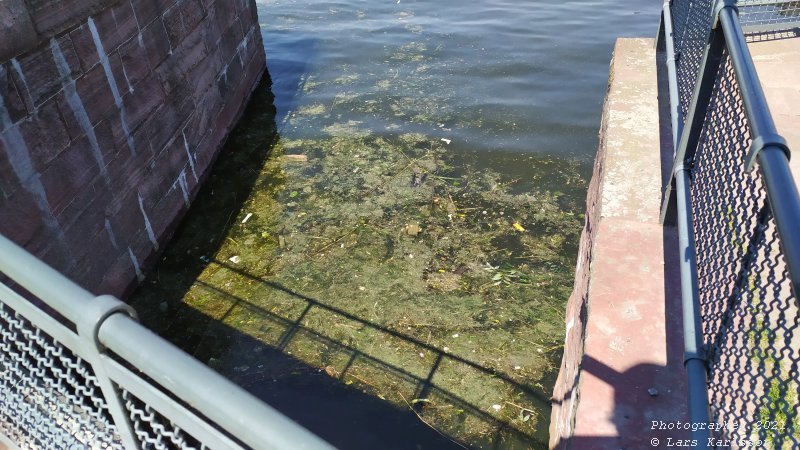
The outlet, doesn't look nice now when the pump is shut down. 
This is the todays Luma dock. Small ferries take you between the islands. This ferry line started 2000, now it's at least three ferry lines. More to read about the ferries at Wikipedia:
|
Sickla Kanal:
After Luma dock we enter to Sickla Channel. Wooden shop:
All along this pier there was a wooden store / shop. My girlfriend remember the marine shop at the end with the name Peters proppshop. 
In the 1960s, it was like slum blocks here, now pretty gardens between the buildings. On the map from 1934 there were nothing here. And in the 1920s it was below the lake's level. 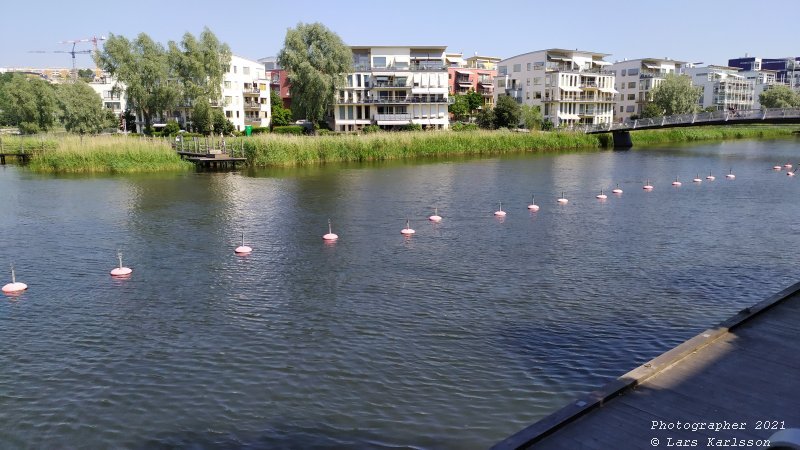
Along this dock there normally a lot of pleasure boats. It's June now and I don't know where all the boats are gone. 
Continue walking to the first bridge over the channel. More to read about Sickla channel at Wikipedia:

A small bridge connect to the other side, only for walking and bicycling. Korphoppsgatan:
The street's name at right in English, Raven jump street, it's a new street. 
After walking halfway along the pier all the pleasure boats appear. 
A view back and we see in the background, Stockholm inner city, Södermalm. Allébron:
Now we have come to the bridge Allébron were the trams, buses and cars drives on. |
|
Advertisement / Annons: |

Bridge of modern steel construction. Sickla Lock:
At the end of the harbor we see for the first time the lock, Sickla Lock. 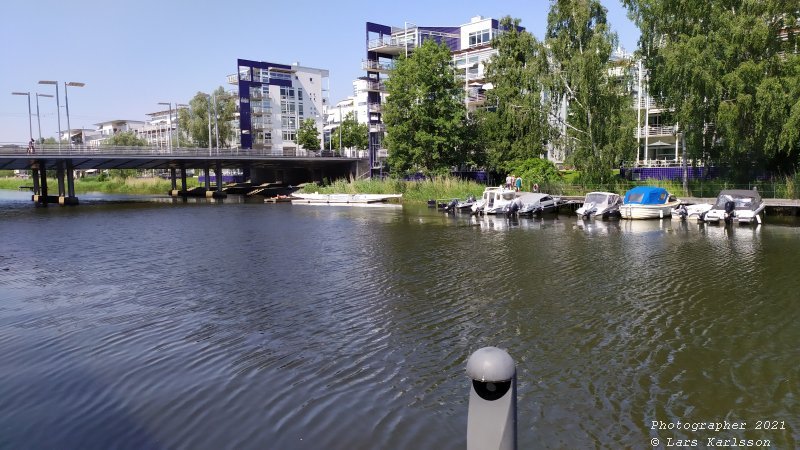
The architecture of the buildings are nice, at least I think so. Not the ordinary grey big square blocks we are used to. 
Another building with a round tower at one end. Big windows with great views over the channel. Sjökrogen:
Close to the lock is this popular inn, Sjökrogen. Sickla Lock:
This lock was built from 1999 to 2003 and replaced the old one from 1928. More to read at Wikipedia:

In the 1990s I was inside and looking at the flat on top of the roof but at the other end. Not too pricy then, today a fortune. 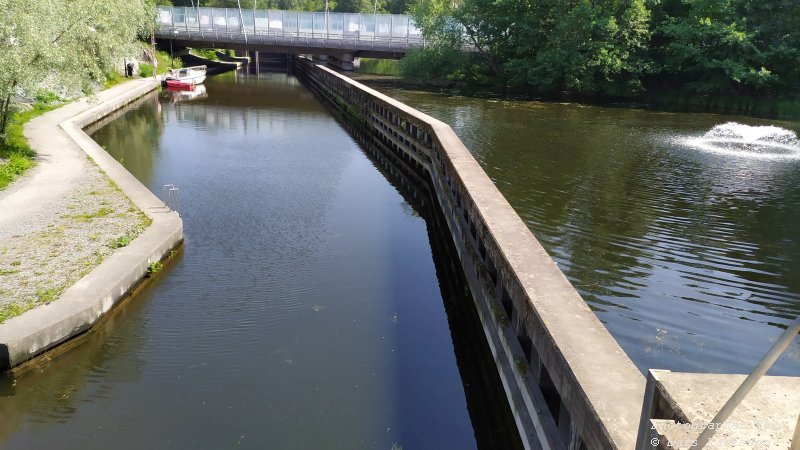
This lock is placed at about the same place as the old one. New is the small lake on the right side which has an outlet to Sickla channel. It's in the form of a stair case for fishes. 
The sea level difference is about 5 meters, that's a lot to be in Stockholm. 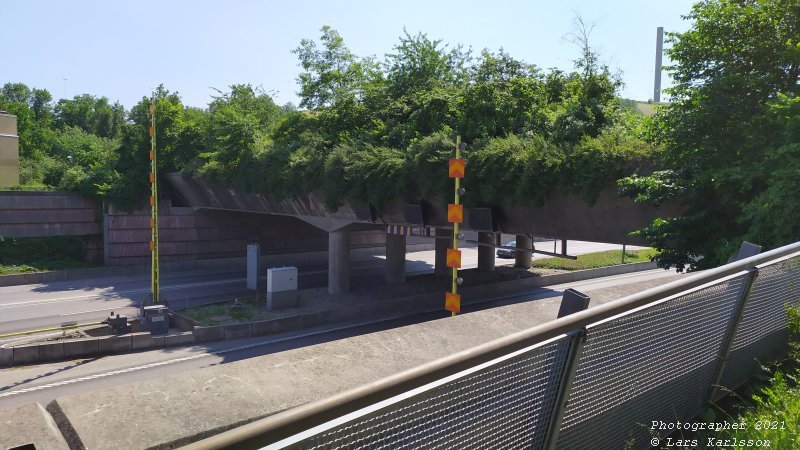
A walking bridge connect to the other side, when walking on that bridge it feels like you are out in the forest. |
Nacka Stad / Stockholms Stad
The border between Nacka's city and Stockholm's city. 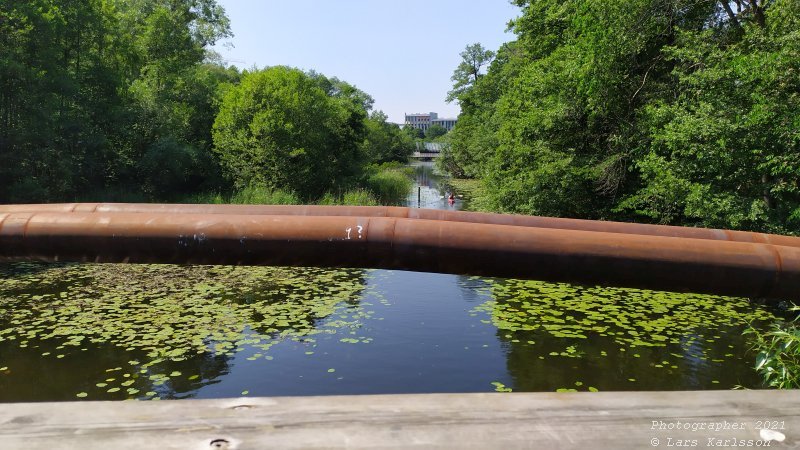
Water tubes run across the channel, not very beautiful. Sicklasjön:
The channel in direction to Sickla lake. Even today there are boats that goes on this channel, the M/S Ran is one of the bigger built 1913 and you can go on a cruise with this ship. More to read about M/S Ran at Wikipedia:

Heat recovery plant. Sickla lock no 2:
Because of the low height of the motorway bridge they had to divide the former lock into two. This is the second lock, without this system of two locks no bigger boats could have entered the Sickla lake. 
Glass windows protect from the motor way. 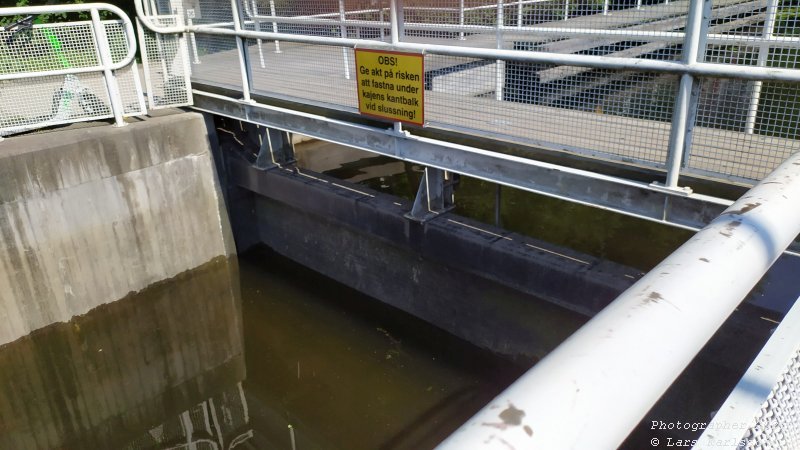
A warning for the edge of the higher part of the lock, when lowering the water level your boat could be stuck on this edge. Not a nice situation ! 
Maximum speed, 5 knots. Hammarby skidbacke:
Did you know that Stockholm has a couple of ski slops ? This is one of them, almost in the city, walking distance. The oldest map I have found with this ski slop is from 1930. Eastern side of Sickla channel: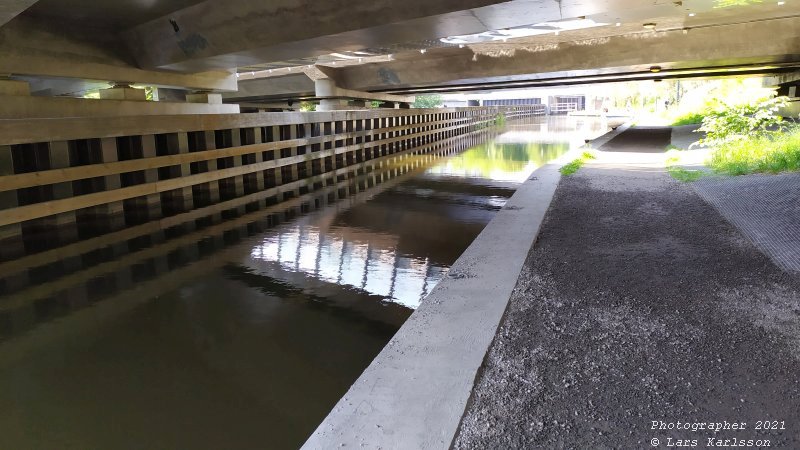
Now we turn around and go back along the Eastern side of Sickla channel. This short channel connect the two locks. |
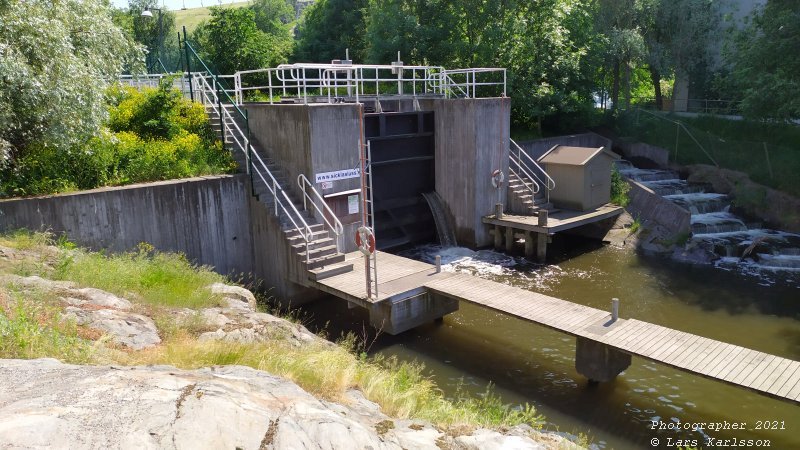
In background the fish staircase that runs parallel to the lock I mentioned earlier. 
Back to Sickla Channel. 
There is a walking path along the beaches and marinas on this side. 
Behind is the Sickla Park. 
Even on this side there are pleasure boat docks. 
Allébron:

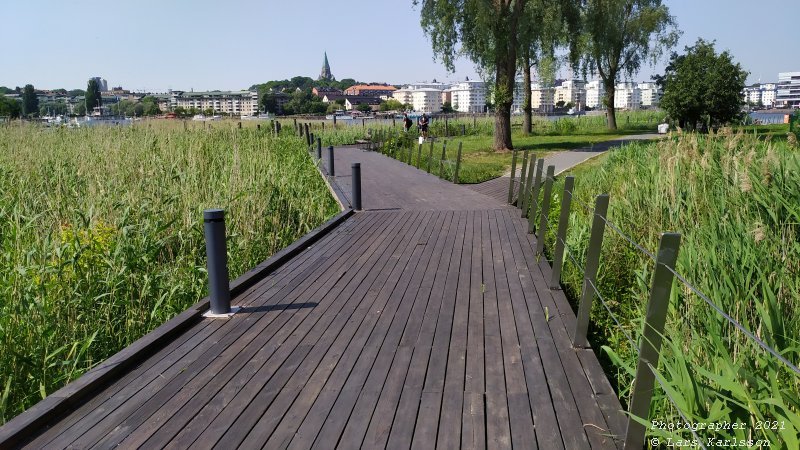
Here the buildings ends and we have a park. 
To the left in background, Södermalm. |
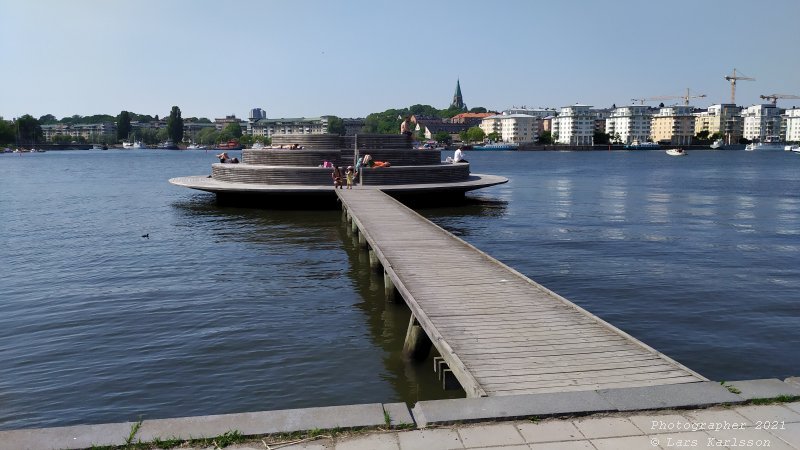
Sunbathing island. 
Across the sea there was another wooden shop, now moved to Årsta and the area now replaced with living blocks. They also have a ferry that connect it to other places around. 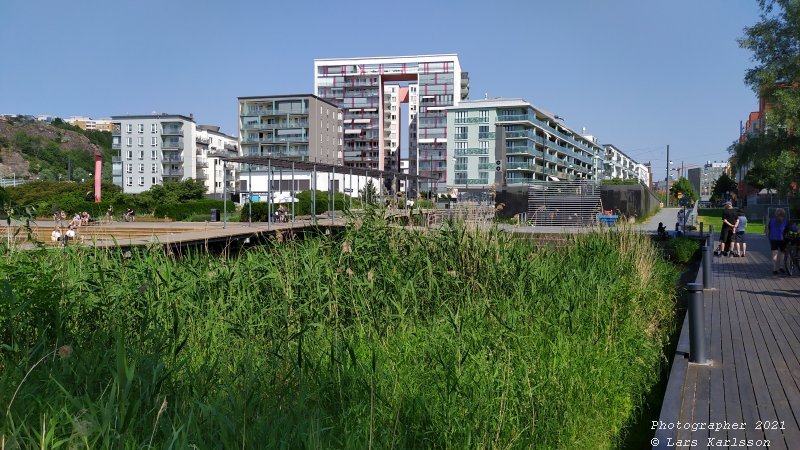
Funny houses with the top floor connecting each other. Now we where hungry and tired, we went back to Skanskvarn for beer and dinner. To all of you who reading this, do you have memories from the earlier industry and places around the Hammarby lake ? Send an email to me and let me know: Contact
|
| Go Back |